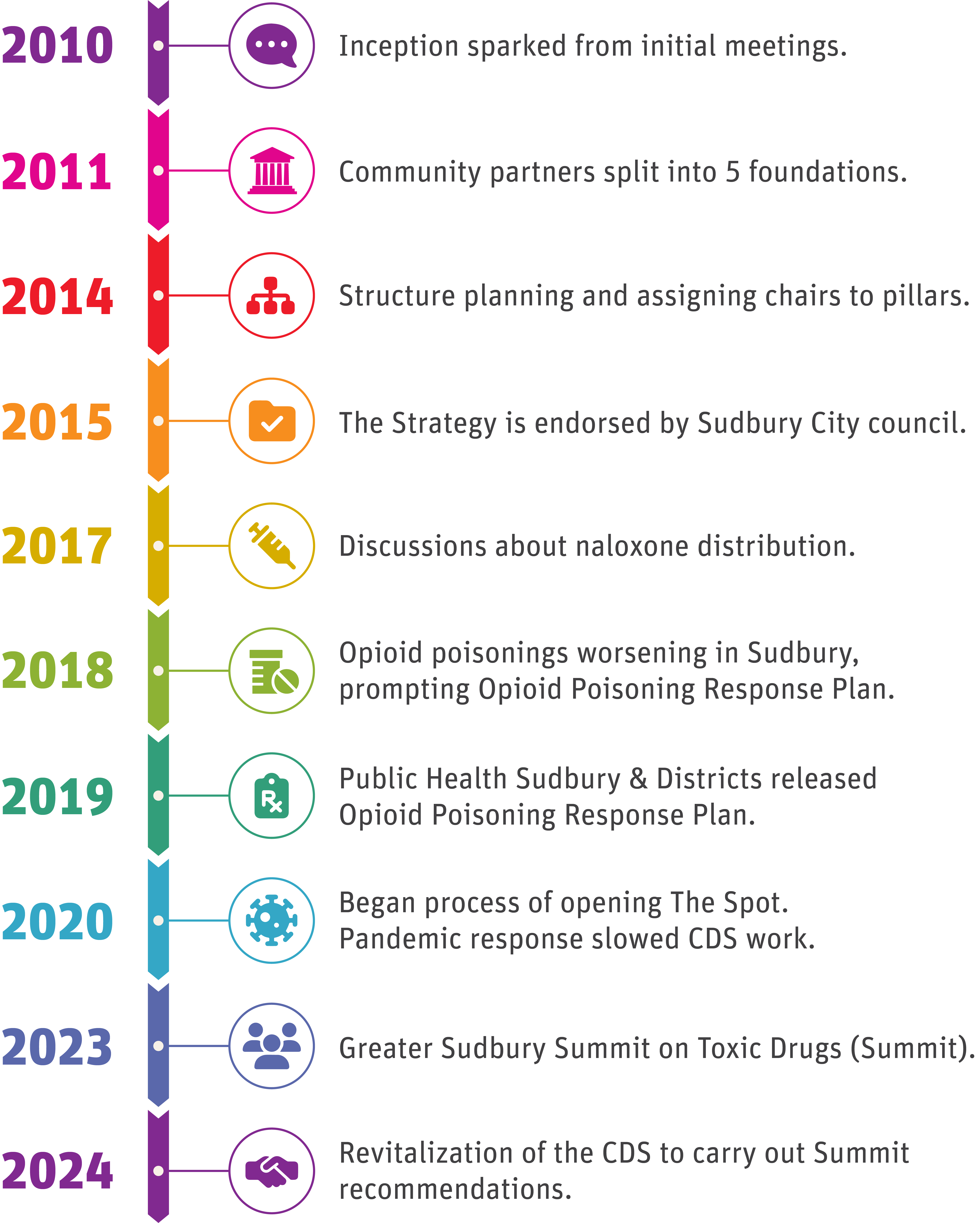History of the Community Drug Strategy (2010-2024)
Over the years since its inception the Community Drug Strategy for the City of Greater Sudbury (CDS) has made much progress and bolstered collaboration amongst many different agencies within the community.
Timeline

2010
Initial meetings sparking the inception of a began in March 2010 to discuss ideas for the foundation of the CDS. Stemming from this initial meeting, a planning committee began working to create a drug strategy with 5 foundations (eventually compressed into 4 foundations).
2011
In June 2011 meetings were held with community partners split into each of the 5 foundations. Following these meetings the Steering Committee for the Community Drug Strategy for the City of Greater Sudbury was established and was comprised of members who represented each of the 5 foundations.
2014
Discussions and meetings surrounding the Community Drug Strategy for the City of Greater Sudbury began in 2014 with structure planning and assigning chairs and co-chairs of pillars.
2015
In October 2015, the Call to Action drafted by the Community Drug Strategy for the City of Greater Sudbury was endorsed by City of Greater Sudbury council. The Call to Action along with an Executive Summary went live to the community in November 2015.
2017
In 2017 there were discussion at the Executive Committee and Steering Committee levels surrounding naloxone distribution and programming for Sudbury as part of the Ontario Naloxone Program.
2018
In 2018 Public Health Sudbury & Districts began signing agreements with community partners to distribute naloxone in Sudbury and Manitoulin districts through the Ontario Naloxone Program.
By 2018 it was very clear that there was an increasing issue with drug poisonings in the area. At this time there was a meeting held to discuss and draft the Opioid Poisoning Response Plan (OPRP) for the City of Greater Sudbury.
2019
In 2019, the severity of the opioid crisis in Sudbury and Manitoulin districts is what triggered PHSD to conduct a needs and feasibility survey (NAFS) for the City of Greater Sudbury.
The NAFS was completed with support from the CDS and the City of Greater Sudbury from July to November 2019. It was composed of a peer-led survey of people who had injected substances within the last 6 months, a community-based online survey through the CDS website, and focus groups held with various community partners who represented various sectors including; addition and treatment, harm reduction, enforcement and justice, health promotion and prevention, business, and community organizations.
In October of 2019 Public Health released the City of Greater Sudbury CDS Opioid Poisoning Response Plan.
2020-2022
In June 2020, A study to explore the need for and feasibility of implementing supervised consumption services in the City of Greater Sudbury (PDF, 1 MB) was published.
The bulk of the work carried out during the COVID-19 pandemic (2020-2022) surrounded the opening of the supervised consumption site. This included navigating through many levels of federal and provincial approvals and multiple layers of stigma.
During the pandemic, Community Drug Strategy work slowed, due to the pandemic response. Moving into recovery in 2022, meetings of the steering committee continued quarterly.
2023
In June 2023, following a presentation to city council by the Office of the Chief Coroner outlining the gravity of the toxic drug crisis the City of Greater Sudbury and PHSD’s Board of Health decided to convene a summit that would bring agency leaders from across the city and beyond together to create a host of recommendations to address the toxic drug crisis.
The Greater Sudbury Summit on Toxic Drugs (Summit) was held on December 7 and 8, 2023. Over 180 people attended the summit to hear 15 speakers and 17 panelists discuss three areas of focus: health promotion and stigma, wrap-around supports, and substance use care (harm reduction and treatment).
2024
A transition task group was struck post summit to determine the best committee within the city to move forward recommendations coming from the Summit. It was decided that the Community Drug Strategy for the City of Greater Sudbury was the body best positioned for the task, it was also recognized that it required renewal and structural change. A report outlining recommendations determined at the summit (PDF, 8 MB) was released January 31, 2024.
In February 2024, a survey was distributed to those who were invited to the Summit requesting their opinions on proposed structure changes and their interest in participating in the revitalized Community Drug Strategy for the City of Greater Sudbury.
On April 4, 2024, the recommendations from the transition task group as well as results from the survey were presented to the previous Community Drug Strategy for the City of Greater Sudbury Executive Committee. The Executive Committee approved the proposed structure for the new Community Drug Strategy.
Nearly 100 people attended the inaugural Community Drug Strategy for the City of Greater Sudbury Steering Committee meeting on April 23, 2024 . Members were divided into the three streams to meet, discuss and collaborate. Moving forward, streams will continue to meet on a regular basis to move forward on action items and build upon priorities from the Summit and will report to the Steering Committee on progress updates.
This item was last modified on December 8, 2025
